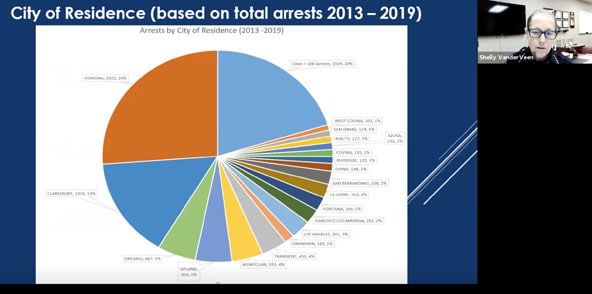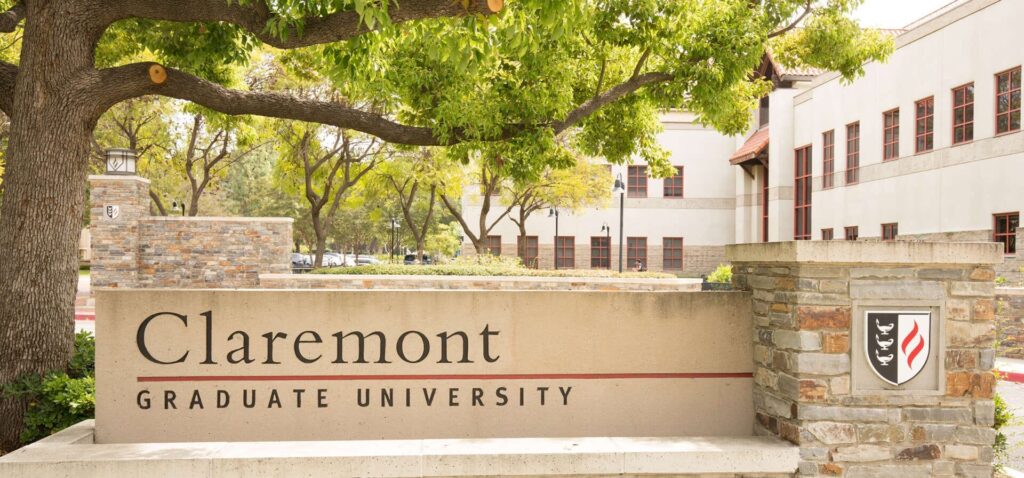Patch redesign, further analysis of arrest data hot topics at meeting

by Steven Felschundneff | steven@claremont-courier.com
If one imagined that Claremont Police Commission meetings during 2020 were going to be difficult and sometimes contentious affairs, that certainly was the case last Tuesday when the commissioners ran into their first public complaints over the largely ceremonial process of choosing a chair and vice chair for the upcoming 12-month period.
The current chair, Frank Bedoya, and commissioner Rolondo Talbott were both nominated to be the new chair. During the voice roll call, the commission elected to retain Mr. Bedoya as chair and assign Mr. Talbot to the vice chair position.
This drew sharp rebuke from the public, with several people expressing concern about the lack of public comment before the vote and it seemed hasty to appoint the chair during the September meeting, given that two new members would be joining the following month, thus denying them any say in commission leadership.
On July 28, followed by a second reading on August 25, the city council voted to temporarily increase the size of the police commission from seven to nine members, adding Becky Margiotta and Rafik Mohamed to the commission.
Claremont Police Chief Shelly Vander Veen explained there was a 30-day wait period and background check for the two new commissioners that had not yet been completed. To settle the situation, Mr. Bedoya suggested that the chair appointments be temp
During public comment, Josue Barnes, co-founder of Claremont Change, called for the resignation of commissioner John Perez specifically because he is the police chief in Pasadena. His department is currently under scrutiny over the killing of Anthony McClain, a 32-year-old Black man, on August 15.
Several more callers echoed Mr. Barnes’ comments and said they did not see how the commission could build a bridge of trust while Mr. Perez was on the commission. He also expressed doubt that it could be a true civilian oversight board with his presence.
In a strong defense of his colleague Mr. Perez, commissioner Caleb Mason, who is a criminal defense attorney, said he had full confidence that Mr. Perez could continue to serve the city of Claremont in a fair and impartial manner.
Commission reviews crime data
The commission requested a deeper analysis of the arrest data that was presented at a previous meeting, which Chief Vander Veen provided.
The data presented spanned 2013 through 2019 and included breakdowns by gender, age, race and city of residence. The data showed that in the city of Claremont, males are three times more likely to be arrested than females and that 38 percent of all arrests were among people between the ages of 20 to 29, followed by 27 percent who were 30 to 39 years of age.
Pomona residents represented 26 percent of arrests during the six-year period, followed by Claremont at 15 percent, Ontario and Upland residents at 5 percent and Montclair residents at 4 percent. Transient and unknown city of residence made up another five percent.
The chief’s presentation provided detailed analysis by type of crime in four categories: health and safety, penal code, vehicle code and warrants. Additionally, each category was further broken down by place of residence and race.
During the July police commission meeting, Chief Vander Veen presented a report that listed arrests by race. Hispanics were the largest group at 47.7 percent, followed by whites at 30 percent, Blacks at 17.8 percent, and Asians at 0.6 percent. Claremont’s population of 36,466 is comprised of 50 percent white, 26.4 percent Hispanic, 13.6 percent Asian and 5.2 percent Black.
Commissioner Mason suggested the data could be further analyzed to determine whether the Claremont Police Department does indeed have a racial profiling problem, and offered that an economist at Claremont McKenna was interested in taking on the task as part of a seminar class.
Using the resources of the Claremont Colleges to further investigate the data received broad support from the commission and the public, however, many cautioned that data on police stops and contacts that did not result in an arrest would be necessary to achieve an accurate picture.
“The most important research on profiling uses police data on stops and searches, not merely arrests,” said Mr. Mohamed, who will be added to the police commission next month. “Anecdotally and personally, like Commissioner Perez, I grew up in a place where I got stopped all the time and never got arrested. So that is where a lot of the friction between the community and the police often exists.”
Mr. Mohamed also expressed his concern that some members of the commission were looking to the data analysis as a way to prove to the public that there is not a police bias problem in Claremont.
“Fundamentally, this should not be about proving anything to the public—it should be about analyzing data. Whatever comes from the data is what gets displayed to the public and demonstrated to the public,” he said.
Mr. Barnes, of Claremont Change, added that the findings and methodology must be public in the interest of reproducibility and transparency.
Commissioner Perez expressed his disappointment that during public comment the focus was on the “Black lived experience” and did not address the Latino community’s experiences.
“It concerns me that we are creating the wrong conversation. This is about the Latino people as well and I want to make sure we don’t forget that voice here on the commission,” he said.
Claremont police patch
Perhaps the most contentious item on the agenda was the proposal to replace the Claremont police patch—which shows two flintlock dueling pistols—with a new design. Commissioner Talbott felt the patch no longer represents the city well because it is much more inclusive now than when it was first approved.
Mr. Mason said his view had changed after hearing from a number of people that the patch made them uncomfortable because it reminds them of the gun in its holster and how it might be used.
“I think that we as a commission, and more importantly as a department and as a community, ought to try and be empathetic about that,” he said.
However, his suggestion for a citywide competition to choose a new design did not sit well with Chief Vander Veen, who believes that the city’s police officers need to create the patch they will wear.
Addressing Commissioner Mason, Chief Vander Veen said: “This uniform is not a tie that you put on to go to court. This patch is imbedded into the heart of the police department, and please hear me when I say this. It’s not the flintlock pistols that I’m talking about. It’s what we know it symbolizes—it’s the dedication to service. So when we put on this uniform it is put on with pride. It’s worn with pride.”
She acknowledged how it may be viewed by those outside the department.
“Knowing how strongly the police department [feels] about this uniform that we put on as we risk our lives for the community, all I ask is that you provide the police department members with the opportunity to present our design ideas for the patch that we will wear before it goes out to the community.”
Chief Vander Veen estimated that replacing the patch would cost $30,000 because of the large number of employees, including officers, staff and volunteers. Final say on the fate of the patch would most likely come before the city council.










0 Comments